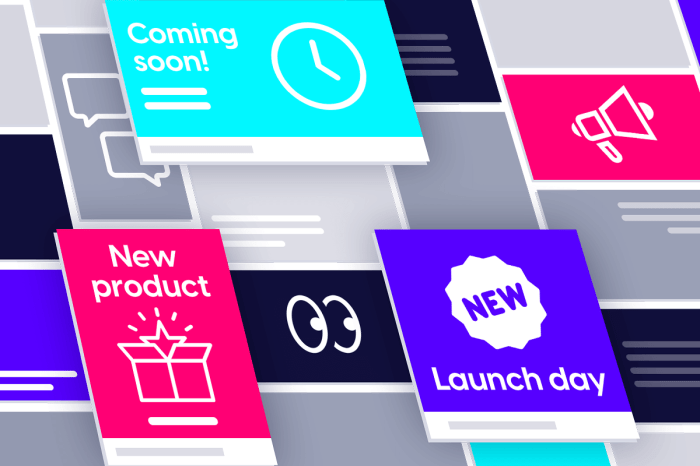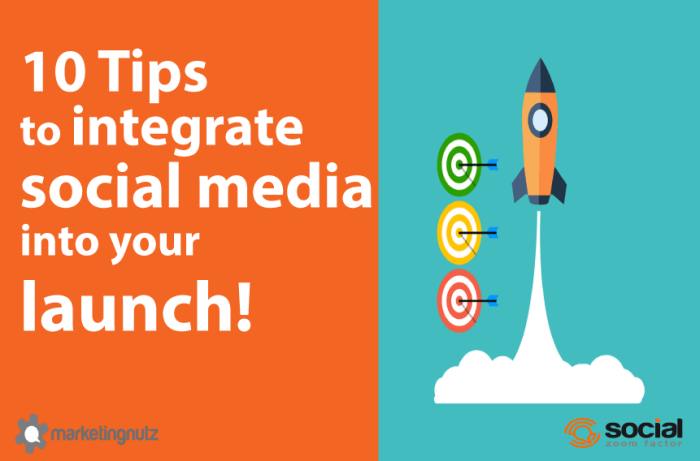Using Social Media for Product Launches sets the stage for a dynamic marketing approach that captures attention, drives anticipation, and boosts engagement. Get ready to dive into the world of social media tactics for successful product launches!
From creating buzz to leveraging user-generated content, this comprehensive guide explores the power of social media in launching products and provides valuable insights for maximizing success.
Importance of Social Media for Product Launches

Social media plays a crucial role in the success of product launches in today’s digital age. With the widespread use of platforms like Facebook, Instagram, Twitter, and TikTok, companies can leverage these channels to generate buzz, increase brand awareness, and engage with their target audience in real time.
Reaching a Wider Audience
Social media allows companies to reach a wider audience compared to traditional marketing methods. Through targeted ads, influencer partnerships, and engaging content, brands can connect with potential customers across the globe. For example, the launch of the iPhone X by Apple in 2017 was heavily promoted on social media, reaching millions of users and creating a massive online buzz.
Successful Campaign Examples
- The #ShareACoke campaign by Coca-Cola, where personalized bottles with people’s names were shared on social media, creating a viral sensation and driving sales.
- The launch of Fenty Beauty by Rihanna, which utilized social media influencers and beauty bloggers to showcase the inclusive range of makeup products, leading to a highly successful debut.
- The #IceBucketChallenge, a viral social media campaign that raised awareness and funds for ALS research, showcasing the power of social media in driving social impact and engagement.
Strategies for Using Social Media in Product Launches
In today’s digital age, social media has become a powerful tool for businesses to reach their target audience and create buzz around new product launches. Here are some effective strategies for utilizing social media in product launches:
Social Media Platforms for Product Launches
When planning a product launch, it’s crucial to choose the right social media platforms that align with your target audience. Different platforms offer unique advantages for product promotion:
- Instagram: Known for its visual appeal, Instagram is ideal for showcasing products through high-quality images and videos. Utilize features like Instagram Stories and IGTV for behind-the-scenes content.
- Facebook: With a wide user base, Facebook is great for creating event pages, running targeted ads, and engaging with followers through live videos and posts.
- Twitter: Perfect for real-time updates and conversations, Twitter can be used to generate excitement around a product launch through hashtags and engaging tweets.
- YouTube: For more in-depth product demonstrations and tutorials, YouTube is a valuable platform to showcase the features and benefits of your product.
It’s essential to tailor your content to each platform’s strengths and engage with your audience in a way that resonates with them.
Leveraging Influencers and Brand Ambassadors
Influencer marketing has become a popular strategy for product promotion on social media. Collaborating with influencers or brand ambassadors can help increase visibility and credibility for your product launch. Here are some tips for leveraging influencers:
- Identify influencers whose values align with your brand and target audience.
- Build authentic relationships with influencers to ensure genuine promotion of your product.
- Provide influencers with creative freedom to showcase your product in a way that feels organic to their followers.
- Track and analyze the performance of influencer collaborations to measure the impact on your product launch.
Creating Buzz and Teasers on Social Media: Using Social Media For Product Launches

Creating buzz and teasers on social media is all about generating excitement and anticipation among your audience leading up to a product launch. By strategically releasing teasers and sneak peeks, you can build momentum, engage your followers, and create a sense of curiosity that will make them eager to learn more about your upcoming product.
Examples of Effective Teaser Campaigns for Product Launches, Using Social Media for Product Launches
- Apple is known for its cryptic teaser campaigns, such as the iconic “There’s something in the air” slogan for the launch of the iPad. This teaser generated buzz and speculation among consumers, leading to high anticipation for the product.
- Beyoncé’s surprise album drops on social media are also great examples of effective teaser campaigns. By suddenly releasing new music without any prior announcement, she creates a sense of excitement and frenzy among her fans.
- The movie industry often uses teaser trailers to generate buzz before a film’s release. These short clips give audiences a taste of what’s to come, building anticipation and driving interest in the movie.
Timing and Frequency of Teaser Posts
Teaser posts should be strategically timed to maintain interest and excitement without giving away too much information too soon. Posting teasers too frequently may lead to oversaturation and decrease the impact of each post.
It’s important to create a schedule for teaser posts leading up to the launch, spacing them out to keep followers engaged and intrigued. Teasers should gradually reveal more about the product as the launch date approaches, building anticipation and excitement among your audience.
Utilizing User-Generated Content for Product Launches
User-generated content plays a crucial role in boosting credibility and engagement for product launches. When customers share their own experiences and reviews, it adds authenticity and trust to the brand, making potential buyers more likely to make a purchase.
Methods for Encouraging Customers to Create and Share Content
- Run contests or challenges where customers can submit photos or videos featuring the upcoming product. Offer prizes or incentives to encourage participation.
- Create a branded hashtag for customers to use when posting about the product on social media. This helps in tracking and showcasing user-generated content.
- Feature user-generated content on your website or social media channels to show appreciation for your customers and encourage others to contribute as well.
- Collaborate with influencers or brand ambassadors to promote user-generated content and engage with a wider audience.
Benefits of Incorporating User-Generated Content in Social Media Campaigns
- Builds credibility: Hearing from real customers about their positive experiences with the product can significantly impact the purchasing decisions of potential buyers.
- Increases engagement: User-generated content often sparks conversations and interactions among followers, leading to higher engagement rates on social media platforms.
- Expands reach: When customers share content related to the product, it reaches a wider audience beyond the brand’s immediate followers, increasing visibility and brand awareness.
- Cost-effective marketing: Utilizing user-generated content reduces the need for expensive ad campaigns and allows the brand to leverage the power of word-of-mouth marketing.
Measuring Success and Analyzing Metrics
In order to gauge the effectiveness of social media campaigns for product launches, it is crucial to track key metrics and analyze the data obtained. This allows companies to optimize future launches and make informed decisions based on performance indicators.
Key Metrics to Track
- Engagement Rate: Measure the level of interaction (likes, comments, shares) your content receives to assess audience interest and involvement.
- Reach: Evaluate the number of unique users who see your posts to determine the extent of your campaign’s visibility.
- Conversion Rate: Track the percentage of users who take desired actions (such as making a purchase) after engaging with your content.
- Click-Through Rate (CTR): Monitor the proportion of users who click on links included in your posts to measure the effectiveness of your call-to-action.
- Sentiment Analysis: Analyze the overall sentiment expressed in comments and mentions to understand how the audience perceives your product.
Analyzing Data for Optimization
After collecting data on the key metrics mentioned above, it is essential to analyze this information to gain insights and optimize future product launches. By examining trends, patterns, and correlations in the data, companies can identify what worked well and what areas need improvement. This allows for strategic adjustments and refinements in upcoming campaigns.
Monitoring Tools and Methods
- Social Media Analytics Platforms: Utilize tools like Facebook Insights, Twitter Analytics, and Instagram Insights to track engagement, reach, and audience demographics.
- Google Analytics: Integrate Google Analytics with your social media accounts to monitor website traffic, conversions, and user behavior resulting from social media referrals.
- URL Tracking: Use unique URLs for different social media posts to track click-through rates and conversions accurately.
- Social Listening Tools: Employ tools like Hootsuite or Sprout Social to monitor brand mentions, sentiment, and overall social media conversations related to your product launch.
